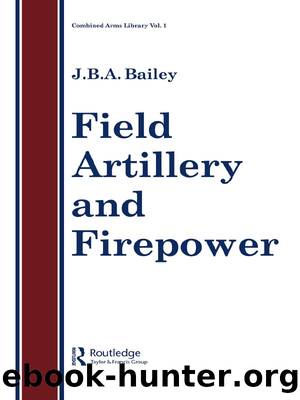Field Artillery And Fire Power by J.B.A Bailey

Author:J.B.A Bailey [Bailey, J.B.A]
Language: eng
Format: epub
Tags: History, General, Technology & Engineering, Military Science
ISBN: 9780203392997
Google: 5doRngEACAAJ
Publisher: Taylor & Francis
Published: 2004-06-19T22:35:18+00:00
B: THE EASTERN FRONT
On 22 June 1941 the Wehrmacht launched Operation BARBAROSSA, the invasion of the USSR. The war on the Eastern Front was a struggle between two antipathetic ideologies, fought by armies with different tactical precepts and logistic resources. By May 1945 these had been put to the test and subjected to a process of evolution. The fundamental issue was the inter-relationship between firepower and mobility. Many of the lessons learned were similar to those experienced in the West; but others were peculiar to the Eastern Front.
Germany invaded the USSR with 3 million men, 600,000 vehicles, 3,580 panzers, 7,184 guns and 1,830 aircraft. However impressive these figures may sound, they were comparable to those engaged in earlier campaigns in much smaller theatres. This force was not intended nor equipped to fight a long war, which Blitzkrieg was designed essentially to avoid. Operation BARBAROSSA sought a quick victory through political and military shock before the USSR and the other major powers could mobilize their potentially much greater materiel resources.
The Wehrmacht could not contemplate a slow, deliberate advance across the steppe. It had therefore to rely on armoured mobility to penetrate and paralyze the opposition, and through mobility to concentrate available firepower at selected points in a vast terrain. It was not so much that the Wehrmacht discounted the value of firepower, as that it recognized Germanyâs inability to win a war fought on terms of comparative mass. Enhanced mobility seemed to offer the only means of circumventing this-unacceptable conclusion.
This concept of operations would have found support in German historical thought, which tended to disparage the value of artillery. Clausewitz had written: âAn excess of guns will impose a more passive and defensive character on operations. Greater reliance will be placed on strong positions, major natural obstacles, and even on positions in mountainous areas. The idea will be to let terrain difficulties take care of the defence and protection of the guns and to let the enemy court his own destruction. The whole war will proceed at the solemn, formal tempo of a minuet. Shortage of artillery will have the opposite effect. It will bring back attack to the foreâthe active principle of movement. Marching, exertion and continuous effort will become arms in themselves, and war will be a brisker, rougher and more variegated business. Great events will be broken down into small change.â (115). BARBAROSSA reflected that spirit. By contrast the USSR was eager to seek salvation in âstrong positionsâ, âmajor natural obstaclesâ, and âan excess of gunsâ.
It was in the Soviet interest to create a Materialschlacht, given their resources of men and materiel. Whereas Germany had learned from the First World War that it must avoid a war of attrition, and so developed alternative tactics which favoured the tank and relied less on artillery, the USSR championed the decisive power of the gun. In 1945 Lieutenant General I.S.Prochko, describing these developments, wrote: âMilitary doctrine fought against theories which tried to belittle the importance of the role of artillery in modern warfare.
Download
This site does not store any files on its server. We only index and link to content provided by other sites. Please contact the content providers to delete copyright contents if any and email us, we'll remove relevant links or contents immediately.
| Anatomy | Animals |
| Bacteriology | Biochemistry |
| Bioelectricity | Bioinformatics |
| Biology | Biophysics |
| Biotechnology | Botany |
| Ecology | Genetics |
| Paleontology | Plants |
| Taxonomic Classification | Zoology |
Sapiens: A Brief History of Humankind by Yuval Noah Harari(14322)
The Tidewater Tales by John Barth(12627)
Mastermind: How to Think Like Sherlock Holmes by Maria Konnikova(7281)
Do No Harm Stories of Life, Death and Brain Surgery by Henry Marsh(6908)
The Thirst by Nesbo Jo(6882)
Why We Sleep: Unlocking the Power of Sleep and Dreams by Matthew Walker(6659)
Life 3.0: Being Human in the Age of Artificial Intelligence by Tegmark Max(5520)
Sapiens by Yuval Noah Harari(5328)
The Longevity Diet by Valter Longo(5044)
The Body: A Guide for Occupants by Bill Bryson(5033)
The Rules Do Not Apply by Ariel Levy(4912)
The Immortal Life of Henrietta Lacks by Rebecca Skloot(4552)
Animal Frequency by Melissa Alvarez(4431)
Why We Sleep by Matthew Walker(4397)
The Hacking of the American Mind by Robert H. Lustig(4342)
Yoga Anatomy by Kaminoff Leslie(4336)
All Creatures Great and Small by James Herriot(4277)
Double Down (Diary of a Wimpy Kid Book 11) by Jeff Kinney(4244)
Embedded Programming with Modern C++ Cookbook by Igor Viarheichyk(4144)
